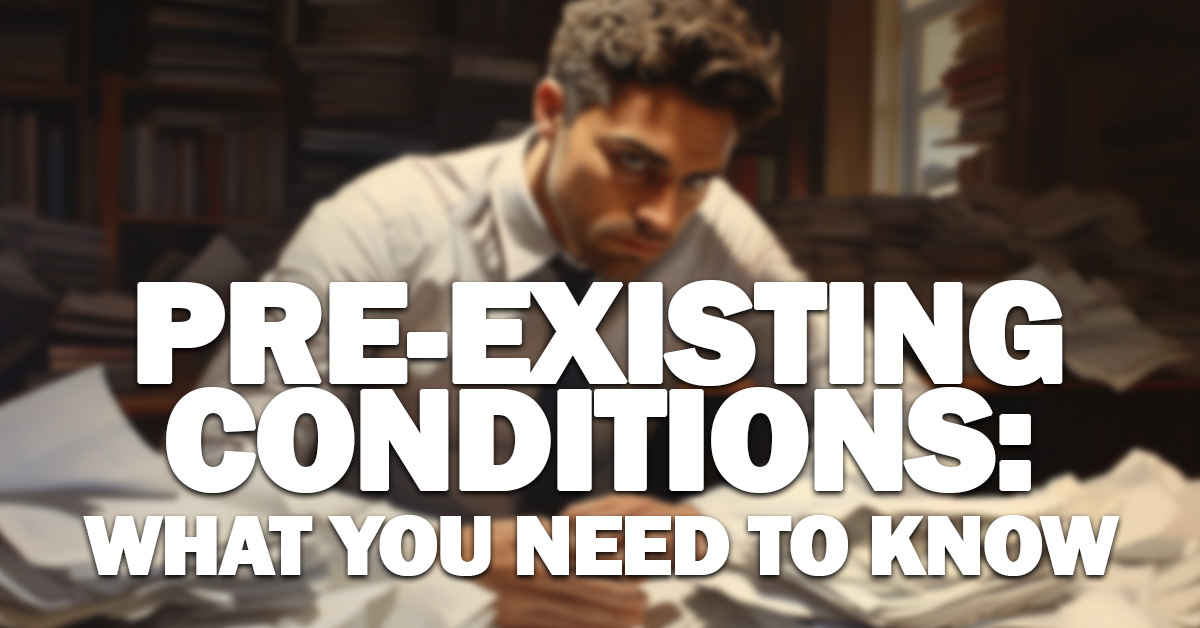Pre-Existing Conditions: What You Need to Know Before You Buy Insurance

Pre-Existing Conditions: What You Need to Know Before You Buy Insurance
Pre-existing conditions are medical conditions that you have before you enroll in an insurance policy. Insurance companies use pre-existing conditions to determine whether to approve your application and what rates to charge you.
In general, pre-existing conditions will not be covered by insurance policies. This is because insurance companies are designed to protect you from future events, not to cover past medical expenses. However, there are a few exceptions to this rule.
Health insurance under the Affordable Care Act (ACA) is available through an open enrollment period each year. During this time, you can apply for coverage regardless of your health status. The ACA also prohibits insurance companies from denying coverage or charging higher rates based on pre-existing conditions.
Medicare also accepts pre-existing conditions in its Initial Enrollment Period (IEP). When you sign up for Medicare Part A for the first time, you have a seven-month IEP during which you cannot be denied coverage or charged higher rates.
Some employer-sponsored health insurance plans also cover pre-existing conditions for new employees. However, the rules for employer-sponsored health insurance vary depending on the size of the company and the plan itself. It is important to check with your employer to see what coverage is available to you.
If you have a pre-existing condition and are not eligible for coverage under one of the exceptions listed above, there are a few things you can do to protect yourself:
- Shop around for different insurance policies. Some insurance companies may be more willing to cover pre-existing conditions than others. Be sure to compare quotes from different companies before you choose a policy.
- Consider purchasing a high-deductible health plan (HDHP). HDHPs typically have lower premiums than other types of health insurance plans, but they also have higher deductibles. This means that you will have to pay more out-of-pocket for medical expenses before your insurance coverage kicks in. However, HDHPs often offer health savings accounts (HSAs), which can help you to save money for medical expenses.
- Look for short-term health insurance plans. Short-term health insurance plans are designed to provide temporary coverage for people who are between jobs or waiting for other coverage to take effect. Short-term health insurance plans typically do not cover pre-existing conditions, but there are a few exceptions.
If you have a pre-existing condition, it is important to talk to an insurance agent to discuss your options. An insurance agent can help you to find the right coverage for your needs and budget.
Additional tips:
- If you are considering buying pet insurance, be sure to read the fine print carefully. Most pet insurance policies do not cover pre-existing conditions, or only cover them after a waiting period.
- If you are considering buying long-term care insurance, it is important to act early. Long-term care insurance premiums are typically based on your age and health status. The earlier you buy long-term care insurance, the lower your premiums will be.
- If you are unsure whether or not you have a pre-existing condition, be sure to talk to your doctor. Your doctor can help you to understand your medical history and determine whether or not you have any pre-existing conditions.
By understanding pre-existing conditions and your insurance options, you can make sure that you have the coverage you need to protect yourself and your family.
Do you have questions about your insurance? Find an insurance agent near you with our Agent Finder
Search All Blogs
Search All Blogs
Read More Insurance Blogs
The Family Legacy: Why December is the Time to Name a Trust as Your Life Insurance Beneficiary
Protect your payout. Discover the benefits of naming a Trust as the beneficiary of your life insurance to control distributions and minimize probate delays.
The Most Sustainable Gift: Life Insurance and the Value of Income Continuation Planning
Life insurance ensures the Christmas cheer continues. Practical tips on using income continuation math to calculate the right term policy size for your family.
The Ultimate December Gift: Why Life Insurance is the Most Important Present You’ll Ever Give
Forget the gadgets; life insurance is the real gift of security. A timely look at protecting your family’s future during the season of giving.
The Modern Parent’s Dilemma: Life Insurance for a Generation of Savers and Investors
Today’s parents have new financial goals. Here’s how life insurance can be a flexible tool for a modern family in 2026.
Life Insurance, Not Just a Death Wish: The 2026 Financial Planning Essential
Life insurance is now a living financial tool. This guide shows how modern policies can help you build wealth and plan for the future.
Beyond the Black and White: The New Reality of Life Insurance in 2026
Life insurance is evolving. Learn how new policies are becoming flexible financial tools for families in 2026.
Your Legacy, Your Way: Life Insurance as a Living Financial Tool for 2026
Life insurance is evolving. Learn how new policies are becoming flexible financial tools to help you build wealth and plan for the future.
The Halloween Legacy: Protecting Your Family’s Future with Life Insurance
A thoughtful guide to life insurance as a legacy for your family.
The October Promise: A Time to Secure Your Family’s Future
A thoughtful guide to understanding life insurance and securing your family’s future.
Beyond a Payout: How Life Insurance is a Living Financial Tool
A guide to how life insurance can be a living financial tool, with a focus on its cash value component.









